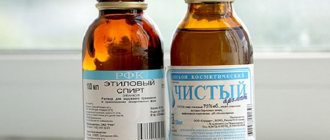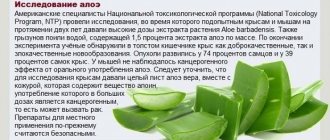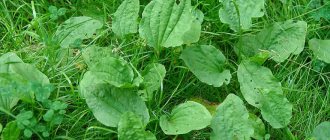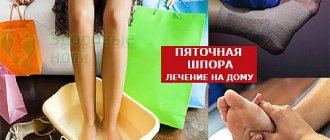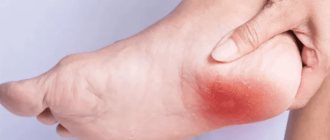special instructions
Before starting treatment, it is advisable for the patient to take a hot shower to mechanically remove mites from the surface of the skin, as well as loosen the surface layer of the epidermis (to facilitate penetration of the drug).
Treatment of patients identified in one outbreak, as well as contact persons, should be carried out simultaneously to avoid re-infection. The persistence of itching after treatment is not an indication for prescribing an additional course of specific therapy. Itching is the body’s reaction to a killed tick and its waste products and disappears when antihistamines and ointments with glucocorticosteroids are prescribed. After treatment, medical supervision is required for 2 weeks, and in the presence of complications, for a longer time.
All items that have come into contact with contaminated skin must be thoroughly treated. Bedding and linen, towels are boiled in a solution of washing powder for 5 - 10 minutes. Outerwear is ironed on both sides with a hot iron. Items that cannot be heat treated are hung out in the open air for 3 days. Shoes, toys and other items are excluded from use for 5 days and placed in a plastic bag. Mattresses, pillows, blankets are also excluded from use for 5 days or are subjected to chamber disinfection. Upholstered furniture can be treated with disinsection preparations. The apartment must be cleaned, the floors washed with detergents or the addition of disinfectants.
It is necessary to avoid getting the drug on the mucous membranes of the eyes, nasal cavity, oral cavity, and genitals. In case of contact, rinse the mucous membranes thoroughly with warm water or 1% - 2% sodium bicarbonate solution (baking soda). If the drug gets into the stomach, you must rinse it with 1% - 2% sodium bicarbonate solution and drink a glass of water with activated carbon (stir 2 tablespoons of activated carbon in a glass of water).
The drug does not have a negative effect on the performance of potentially hazardous activities that require special attention and quick reactions (driving a car, etc.).
Emulsion for treating scabies at home
Registration number
P N001773/01.
Tradename:
Benzyl benzoate
International nonproprietary or chemical name:
Benzyl benzoate
Dosage form:
Emulsion for external use.
Compound:
- Active ingredient:
benzyl benzoate – 200.0 mg. - Excipients:
solid laundry soap - 10.0 mg, emulsion wax - 10.0 mg, purified water up to 1.0 g.
Description:
A homogeneous emulsion of white or almost white color with a slight specific odor. Emulsion particles are allowed to settle and disappear after shaking.
Pharmacotherapeutic group:
Anti-scabbing agent.
ATX code:
(P03AX01).
pharmachologic effect
Antiparasitic drug for external use. It has a toxic effect on various types of mites, including scabies, and exhibits anti-pediculosis activity. It passes through the chitinous cover and accumulates in the tick's body in toxic concentrations (the death of ticks occurs after 7-32 minutes). Causes the death of larvae and adults of scabies mites.
Pharmacokinetics
Penetrates the upper layers of the epidermis and is not absorbed into the systemic circulation.
Indications for use
Benzyl benzoate is used to treat scabies.
Contraindications
Hypersensitivity. Not recommended for use in children under 3 years of age.
Pregnancy and lactation
It is not recommended for use by pregnant women or during breastfeeding.
Directions for use and doses
The course of treatment lasts 5 days. Adults are prescribed a 20% emulsion, and children under 5 years old – 10% (the drug is diluted with boiled water in a 1:1 ratio).
Externally. The emulsion is thoroughly rubbed with your hands after washing at night over the entire skin, excluding the face and scalp. Hands are not washed until the morning. 50–100 g of emulsion is consumed per treatment. On the 2nd and 3rd days they take a break from treatment, while the remnants of the emulsion are not washed off from the skin, and the bed linen is not changed. On the 4th day the treatment is repeated. The emulsion is completely washed off the skin on the fifth day with warm water and soap without rubbing the skin. Underwear and bed linen are changed after each treatment.
Side effect
Allergic reactions. Local reactions: possible (especially in children) burning sensation, skin irritation. If signs of skin irritation appear, stop using the drug.
Overdose
Not identified.
Interaction with other drugs
No pharmacological interactions with other drugs have been identified; however, like all antiparasitic agents, benzyl benzoate is not recommended for use simultaneously with other external medications.
special instructions
Treatment of complications of scabies (dermatitis, eczema, pyoderma, postscabiosis lymphoplasia) should be carried out simultaneously with treatment of scabies and continue after its completion.
Treatment of patients identified in one outbreak, as well as contact persons, should be carried out simultaneously to avoid re-infection.
The persistence of itching after treatment is not an indication for prescribing an additional course of specific therapy. Itching is the body’s reaction to a killed tick and its waste products and disappears when antihistamines and ointments with glucocorticosteroids are prescribed.
All items that have come into contact with contaminated skin must be treated. Disinfection of bedding, underwear and towels can be carried out by boiling in a 1-2% solution of soda or any washing powder for 5-7 minutes from the moment of boiling or by soaking for an hour in chlorine-containing solutions. Outerwear (dresses, trousers, suits, jumpers, etc.) are disinfected by ironing on both sides with a hot iron. Some items, especially those that cannot be heat treated, can be hung out in the open air for 3 days. To disinfect some things (children's toys, shoes, clothes), you can use a method of temporarily excluding them from use, for which they are placed in hermetically sealed plastic bags for 3 days. Mattresses, pillows, blankets are excluded from use for 5 days or are subjected to chamber disinfection. Upholstered furniture can be treated with disinsection preparations. The apartment must be cleaned, the floors washed with detergents or the addition of disinfectants.
It is necessary to avoid getting the drug on the mucous membranes of the eyes, nose, mouth, and genitals. In case of contact, rinse the mucous membranes thoroughly with warm water or 1% - 2% sodium bicarbonate solution (baking soda). If the drug gets into the stomach, you must rinse it with a 1% - 2% solution of sodium bicarbonate and drink a glass of water with activated carbon (stir 6 crushed tablets of activated carbon in ½ glass of water).
The drug does not affect the ability to drive a car or perform work that requires increased concentration.
Release form
Emulsion for external use 20%.
50, 100 and 200 g in dark glass bottles with a screw neck, sealed with plastic stoppers and screw caps or screw caps complete with a sealing gasket and with or without tamper evident.
Each bottle, along with instructions for use, is placed in a cardboard pack.
Storage conditions
At temperatures from 15 to 25 °C. Keep out of the reach of children.
Best before date
3 years. Do not use after expiration date.
Conditions for dispensing from pharmacies
Available without a prescription.
Directions for use and doses
Externally. For adults, use 20% ointment, for children - 10%. The course of treatment lasts 4 days. On the first day, after washing at night, the ointment is applied to the entire skin, excluding the face and scalp, rubbed in with hands that are not washed until the morning, 30 - 40 g of ointment is used for one rub. In areas with delicate skin, the ointment is applied without intensive rubbing. After treating the skin, only clean linen and clothing should be used. On the 2nd and 3rd days they take a break from treatment, while the remaining ointment is not washed off from the skin. On the 4th day in the evening, the patient washes with soap and rubs in the ointment as on the first day, and once again changes all the underwear. If the ointment is washed off from your hands or other areas of the skin, they must be re-treated. The ointment is completely washed off the skin on the fifth day of treatment.
Registration number
P N001773/01.
Tradename:
Benzyl benzoate
International nonproprietary or chemical name:
Benzyl benzoate
Dosage form:
Emulsion for external use.
Compound:
- Active ingredient:
benzyl benzoate – 200.0 mg. - Excipients:
solid laundry soap - 10.0 mg, emulsion wax - 10.0 mg, purified water up to 1.0 g.
Description:
A homogeneous emulsion of white or almost white color with a slight specific odor. Emulsion particles are allowed to settle and disappear after shaking.
Pharmacotherapeutic group:
Anti-scabbing agent.
ATX code:
(P03AX01).
pharmachologic effect
Antiparasitic drug for external use. It has a toxic effect on various types of mites, including scabies, and exhibits anti-pediculosis activity. It passes through the chitinous cover and accumulates in the tick's body in toxic concentrations (the death of ticks occurs after 7-32 minutes). Causes the death of larvae and adults of scabies mites.
Pharmacokinetics
Penetrates the upper layers of the epidermis and is not absorbed into the systemic circulation.
Indications for use
Benzyl benzoate is used to treat scabies.
Contraindications
Hypersensitivity. Not recommended for use in children under 3 years of age.
Pregnancy and lactation
It is not recommended for use by pregnant women or during breastfeeding.
Directions for use and doses
The course of treatment lasts 5 days. Adults are prescribed a 20% emulsion, and children under 5 years old – 10% (the drug is diluted with boiled water in a 1:1 ratio).
Externally. The emulsion is thoroughly rubbed with your hands after washing at night over the entire skin, excluding the face and scalp. Hands are not washed until the morning. 50–100 g of emulsion is consumed per treatment. On the 2nd and 3rd days they take a break from treatment, while the remnants of the emulsion are not washed off from the skin, and the bed linen is not changed. On the 4th day the treatment is repeated. The emulsion is completely washed off the skin on the fifth day with warm water and soap without rubbing the skin. Underwear and bed linen are changed after each treatment.
Side effect
Allergic reactions. Local reactions: possible (especially in children) burning sensation, skin irritation. If signs of skin irritation appear, stop using the drug.
Overdose
Not identified.
Interaction with other drugs
No pharmacological interactions with other drugs have been identified; however, like all antiparasitic agents, benzyl benzoate is not recommended for use simultaneously with other external medications.
special instructions
Treatment of complications of scabies (dermatitis, eczema, pyoderma, postscabiosis lymphoplasia) should be carried out simultaneously with treatment of scabies and continue after its completion.
Treatment of patients identified in one outbreak, as well as contact persons, should be carried out simultaneously to avoid re-infection.
The persistence of itching after treatment is not an indication for prescribing an additional course of specific therapy. Itching is the body’s reaction to a killed tick and its waste products and disappears when antihistamines and ointments with glucocorticosteroids are prescribed.
All items that have come into contact with contaminated skin must be treated. Disinfection of bedding, underwear and towels can be carried out by boiling in a 1-2% solution of soda or any washing powder for 5-7 minutes from the moment of boiling or by soaking for an hour in chlorine-containing solutions. Outerwear (dresses, trousers, suits, jumpers, etc.) are disinfected by ironing on both sides with a hot iron. Some items, especially those that cannot be heat treated, can be hung out in the open air for 3 days. To disinfect some things (children's toys, shoes, clothes), you can use a method of temporarily excluding them from use, for which they are placed in hermetically sealed plastic bags for 3 days. Mattresses, pillows, blankets are excluded from use for 5 days or are subjected to chamber disinfection. Upholstered furniture can be treated with disinsection preparations. The apartment must be cleaned, the floors washed with detergents or the addition of disinfectants.
It is necessary to avoid getting the drug on the mucous membranes of the eyes, nose, mouth, and genitals. In case of contact, rinse the mucous membranes thoroughly with warm water or 1% - 2% sodium bicarbonate solution (baking soda). If the drug gets into the stomach, you must rinse it with a 1% - 2% solution of sodium bicarbonate and drink a glass of water with activated carbon (stir 6 crushed tablets of activated carbon in ½ glass of water).
The drug does not affect the ability to drive a car or perform work that requires increased concentration.
Release form
Emulsion for external use 20%.
50, 100 and 200 g in dark glass bottles with a screw neck, sealed with plastic stoppers and screw caps or screw caps complete with a sealing gasket and with or without tamper evident.
Each bottle, along with instructions for use, is placed in a cardboard pack.
Storage conditions
At temperatures from 15 to 25 °C. Keep out of the reach of children.
Best before date
3 years. Do not use after expiration date.
Conditions for dispensing from pharmacies
Available without a prescription.
Benzyl benzoate 20% emulsion for external use approx 200g
Benzyl benzoate emulsion - instructions for use
Trade name of the drug: Benzyl benzoate
International nonproprietary name (INN) or generic name: Benzyl benzoate
Dosage form: emulsion for external use.
Composition Active ingredient: benzyl benzoate 200 mg.
Excipients: laundry soap 72%, emulsion wax, purified water up to 1 g.
Description homogeneous white emulsion with a weak specific odor.
Pharmacotherapeutic group: anti-scabies.
ATX code P03AX01
Pharmacological properties It has a toxic effect on various types of mites, including scabies, and exhibits anti-pediculosis activity.
Indications for use Benzyl benzoate is used to treat scabies
Contraindications Hypersensitivity.
Not recommended for use in children under 3 years of age.
Pregnancy and lactation It is not recommended for use by pregnant women and during breastfeeding.
Method of administration and dosage The course of treatment lasts 4 days.
Adults are prescribed a 20% emulsion, and children under 5 years of age are prescribed 10% (the drug is diluted with boiled water in a 1:1 ratio).
On the first day, treatment is carried out in the evening before bed after washing thoroughly in the shower with warm water and soap. The emulsion is rubbed into the skin of the hands, then the torso and legs, including the soles and fingers. After treating the skin, only clean linen and clothing should be used. On the 2nd and 3rd days, a break in treatment is taken, while the remnants of the emulsion are not washed off from the skin. On the 4th day in the evening, the patient washes with soap and rubs in the emulsion as on the first day, using the remaining emulsion, and changes all the underwear again. Hands should not be washed for 3 hours after treatment; Subsequently, hands are treated with emulsion after each wash. If the emulsion is washed off from other areas of the skin, they must also be re-treated. The emulsion is completely washed off the skin on the fifth day. Treatment of complications of scabies (dermatitis, eczema, pyoderma, postscabiosis lymphoplasia) should be carried out simultaneously with treatment of scabies and continue after its completion. Side effects Allergic reactions.
Local reactions: possible (especially in children) burning sensation, skin irritation.
If signs of skin irritation appear, stop using the drug. Overdose Not detected.
Interaction with other drugs Not detected.
Special instructions Treatment of patients identified in one outbreak, as well as contact persons, should be carried out simultaneously to avoid re-infection.
The persistence of itching after treatment is not an indication for prescribing an additional course of specific therapy.
Itching is the body’s reaction to a killed tick and its waste products and disappears when antihistamines and ointments with glucocorticosteroids are prescribed. All items that have come into contact with infected skin must be thoroughly treated. Bed linen and towels are boiled in a solution of washing powder for 5-10 minutes. Outerwear is ironed on both sides with a hot iron. Items that cannot be heat treated are hung out in the open air for 3 days. Shoes, toys and other items are placed in a plastic bag and excluded from use for 5 days. Mattresses, pillows, blankets are also excluded from use for 5 days or are subjected to chamber disinfection. Upholstered furniture can be treated with disinsection preparations. The apartment must be cleaned, the floors washed with detergents or the addition of disinfectants. It is necessary to avoid getting the drug into the eyes, nose, and mouth. If the drug gets into your mouth and nose: rinse with plenty of water or a 2% solution of warm baking soda; into eyes: rinse thoroughly with water. Release form Emulsion for external use 20% in vials and bottles of 50 g, 100 g and 200 g.
Each vial, bottle, along with instructions for medical use, is placed in a cardboard pack.
Storage conditions At temperatures from 18 to 22C.
Keep out of the reach of children.
Shelf life: 2 years.
Do not use after expiration date.
Conditions for dispensing from pharmacies Without a prescription.
The appearance of the product may differ from the photographs on the website.
Information about medications posted on the site is intended for specialists and includes materials from publications from different years. The information provided on the site is general and is presented for informational purposes only, does not replace consultation with a doctor and cannot serve as a guarantee of the positive effect of the drug. Tvoyaapteka.rf warns you about possible negative consequences that may arise as a result of incorrect use of the information presented on the site and strongly recommends that you consult with a specialist before choosing a drug.
You can find detailed and up-to-date instructions for the drug on the website of the State Register of Medicines www.grls.rosminzdrav.ru.
